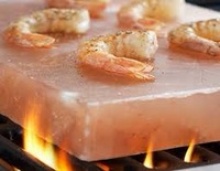Product description
Guide to Use Himalayan Salt Bricks/Blocks/Slabs
A boulder of Himalayan rock salt emerges from darkness of a 16th century mineshaft in Pakistan and explodes into light, catching and refracting the sun in hues ranging spring water clear to hibiscus pink to venison red. Stonemasons in a neighboring town then hand cut the great rock into a variety of shapes, providing the foundation for extraordinary new ways to prepare and serve food.
The BUSINESS RESOURCES PAKISTAN 's Himalayan salt blocks, plates, bricks, and platters can be used for sautéing, grilling, chilling, curing, baking, presenting, salting, bathing, building, and contemplating.
There are as many uses for The BUSINESS RESOURCES PAKISTAN's heavy slabs of Himalayan Pink Salt blocks as there are foods, cooking styles, whims, acts of folly, and shows of bravado. Serve moist food on it, such as mozzarella and sliced apples, and the food will pick up a delicate saltiness that sets it off perfectly. Heat a salt block on the stove, then set the hot block on a trivet at the table to sear scallops or thinly sliced hanger steak while seated with your guests.
A. Cooking on a Salt Block
The crystal lattice of our Himalayan Pink Salt Blocks has a high specific energy (energy per unit of mass), so they hold any temperature you bring it to for a good while. Likewise, this makes for excellent heat distribution, making grandma's heavy old cast iron skillet seem like tinfoil by comparison.
Because Himalayan Salt Blocks generally have an extremely low amount of porosity, and virtually no residual moisture (.026%), the salt plates can be safely heated or chilled to great extremes. We have tested them from 0°F up to 700°F (-18°C to 370°C). Salt melts at 1473.4°F (800.8°C).
Two other considerations come into play when working with our Himalayan salt blocks. First, their lack of porosity means that the surface area touching your food is minimal, so these large blocks of salt will impart only a very moderate saltiness. Second, the high quantity of trace minerals (1.2% sulfur, .4% calcium, .35% potassium, .16% magnesium, and 80 other trace minerals) impart a more mild and full taste to the salt, and by extension, more flavor complexity to your food.
